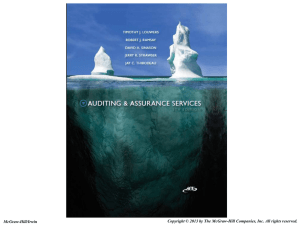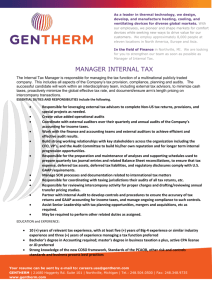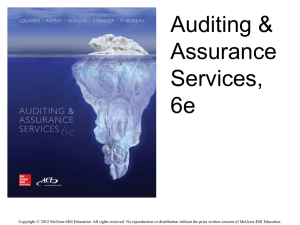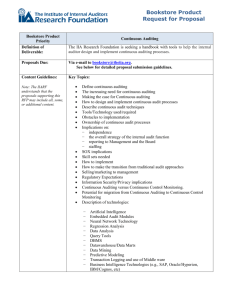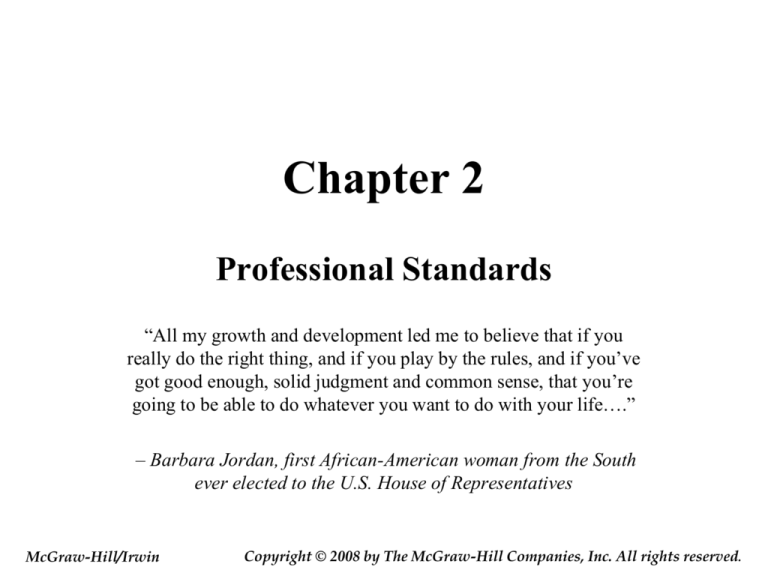
Chapter 2
Professional Standards
“All my growth and development led me to believe that if you
really do the right thing, and if you play by the rules, and if you’ve
got good enough, solid judgment and common sense, that you’re
going to be able to do whatever you want to do with your life….”
– Barbara Jordan, first African-American woman from the South
ever elected to the U.S. House of Representatives
McGraw-Hill/Irwin
Copyright © 2008 by The McGraw-Hill Companies, Inc. All rights reserved.
2-2
Practice Standards
Client
Public
Entities
Private
Entities
Governmental
Entities
Foreign
Entities
Rulemaking
body
Public Company
Accounting
Oversight Board
(PCAOB)
AICPA Auditing
Standards Board
(ASB)
U.S.
Government
Accountability
Office (GAO)
IFAC International
Auditing and
Assurance
Standards Board
(IAASB)
Standards
Auditing
Standards (ASs)
Statements on
Auditing
Standards
(SASs)
Government
Auditing
Standards
(The “Yellow
Book”)
International
Standards on
Auditing (ISAs)
Web site
www.pcaobus.org
www.aicpa.org
www.gao.gov
www.ifac.org
2-3
Generally Accepted Auditing
Standards
• Measures of the quality of auditors’
performance
• Same from audit to audit
• Auditing standards versus auditing
procedures
Exhibit 2.1
Generally Accepted Auditing Standards
2-4
2-5
Engagement Overview and GAAS
OBTAIN
(OR RETAIN)
CLIENT
ENGAGEMENT
PLANNING
RISK
ASSESSMENT
SUBSTANTIVE
PROCEDURES
ISSUE
REPORT
General Standards (Due Professional Care)
Standards of Field Work
Standards of
Reporting
2-6
General Standards
Affect all phases of audit
1. Training and proficiency
– Experience and expertise
2. Independence
– Independence in fact vs. independence in appearance
– Financial and managerial relationships
3. Due professional care
– Observe standards of field work and standards of
reporting.
2-7
Standards of Field Work
Affect conduct of the audit
1. Planning and supervision
–
–
2.
Use of audit program
Interim and year-end work
Understanding of entity and environment (including I/C)
–
–
3.
Assess risk of material misstatement
Determine effectiveness of substantive procedures
Sufficient appropriate evidence
–
–
Sufficient = quantity
Appropriate = quality (relevance, reliability)
2-8
Sufficient evidence
• Related to quantity (number of transactions
or components examined)
• Influenced by effectiveness of entity’s
internal control
Effective internal
control
Lower level of
control risk
Reduced effectiveness of
substantive procedures
Ineffective internal
control
Higher level of
control risk
Increased effectiveness of
substantive procedures
2-9
Appropriate Evidence
• Relates to the quality of evidence
• Reliability (from highest to lowest)
–
–
–
–
–
Auditors’ direct personal knowledge
External documentary evidence
External-internal evidence
Internal documentary evidence
Verbal and written representations
2-10
Examples of Evidence
• Auditors’ direct personal knowledge
– Observe PPE, inventories
• External documentary evidence
– A/R confirmations, bank confirmations
• External-internal evidence
– Vendor invoices for purchases
• Internal documentary evidence
– Client sales invoices
• Verbal and written representations
– Management representations (SAS 85)
2-11
Standards of Reporting
Identify contents of auditors’ reports
1. Are F/S in conformity with GAAP?
2. Have GAAP been consistently applied
(implicit reporting)?
3. Are disclosures adequate (implicit reporting)?
4. Report must express or disclaim an opinion
2-12
Independent Auditors’ Report (AS 5)
Report Title
Report of Independent Registered Public Accounting Firm
Report Address
To the Board of Directors and Shareholders
APOLLO SHOES, INC.
Introductory
Paragraph
We have audited the accompanying balance sheets of APOLLO SHOES, INC. as of December 31, 2008 and 2007,
and the related statements of income, comprehensive income, shareholders’ equity, and cash flows for each of the
years in the three-year period ended December 31, 2008. These financial statements are the responsibility of the
APOLLO SHOES, INC.’s management. Our responsibility is to express an opinion on these financial statements
based on our audits.
Scope
Paragraph
We conducted our audits in accordance with the standards of the Public Company Accounting Oversight Board
(United States). Those standards require that we plan and perform the audit to obtain reasonable assurance about
whether the financial statements are free of material misstatement. An audit includes examining, on a test basis,
evidence supporting the amounts and disclosures in the financial statements. An audit also includes assessing the
accounting principles used and significant estimates made by management, as well as evaluating the overall
financial statement presentation. We believe that our audits provide a reasonable basis for our opinion.
Opinion
Paragraph
Internal Control
Paragraph (AS 5)
Signature
Report Date
In our opinion, the financial statements referred to above present fairly, in all material respects, the financial
position of APOLLO SHOES, INC. as of December 31, 2008 and 2007, and the results of its operations and its
cash flows for each of the years in the three-year period ended December 31, 2008 in conformity with accounting
principles generally accepted in the United States of America.
We also have audited, in accordance with the standards of the Public Company Accounting Oversight Board
(United States), APOLLO SHOES INC.’S' internal control over financial reporting as of December 31, 2008,
based on criteria established in Internal Control-Integrated Framework issued by the Committee of Sponsoring
Organizations of the Treadway Commission (COSO), and our report dated January 29, 2009 expressed an
unqualified opinion on the effective operation of internal control over financial reporting.
Smith & Smith, CPAs
January 29, 2009
2-13
Types of Audit Opinions
• Unqualified
– F/S are in conformity with GAAP
• Qualified
– Except for one (limited) item, F/S are in conformity with GAAP
– Can issue for GAAP departure and scope limitation
• Adverse
– F/S are not in conformity with GAAP
– Can issue for GAAP departure (more serious)
• Disclaimer
– Auditors do not express an opinion
– Can issue for scope limitation (more serious)
2-14
Attestation Standards
• Cover a broader range of engagements than
GAAS
• Differences from GAAS
– Subject matter must be evaluated against
reasonable criteria
– No requirement to assess risk of material
misstatement (unless attestation engagement
involves risk of material misstatement)
– May have limited distribution of report
2-15
Quality Control Standards for Accounting
Firms
• Guide the performance of firm-wide services
• Categories
– Independence, integrity, objectivity
– Personnel management
– Acceptance and continuance of clients
– Engagement performance
– Monitoring
2-16
The Public Company Accounting
Oversight Board (PCAOB)
• Establishes standards (Auditing Standards)
–
–
–
–
Auditors’ reports (AS 1)
Audit documentation (AS 3)
Material weaknesses in internal control (AS 4)
Audits of internal control over financial reporting (AS
5)
• Standards must be approved by SEC
• ASB and AICPA standards prior to April 16, 2003
are Interim Auditing Standards
– May be modified or amended by Auditing Standards
2-17
The Public Company Accounting
Oversight Board (PCAOB)
• Monitors accounting firms through inspections
– Firms auditing > 100 public entities: annual
– Firms auditing < 100 public entities: every 3 years
• Inspection reports list deficiencies in audits
conducted by registered firms

